From the website: “Project E-MANcipate is a project to accelerate the acceptance of male pantyhose as a regular clothing item.”
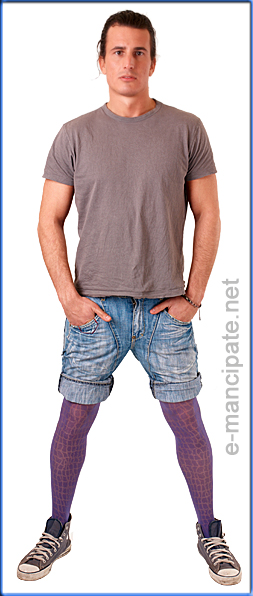
Hey, I’m all for men and women wearing pantyhose if they want to (as long as no one makes me wear any) but what sort of “emancipation” is being advocated?
Is this about emancipation men from the confines of masculinity so that they can wear an item associated with femininity?
“Men who wear pantyhose do it to improve athletic performance, energize and revitalize tired, aching leg muscles, and to stimulate circulation if they sit all day. In addition, compression can help reduce swelling and decrease the dangers of circulatory problems. And of course there are many men who simply like the soft material and the comfort that sheer pantyhose provides.”
So men would mostly wear pantyhose for (manly) athletic reasons. And, as the website also notes, to keep warm in the winter. But, some men might just like “the soft material.” What about them?
Or maybe the point is to emancipate pantyhose from being associated with only femininity?
“Since pantyhose (or tights), as a garment, has about it nothing gender-specific (such as a panty that fits only the female body, or a bra that is ‘organ-specific’), there is no reason why people of either sex should think of it as a female-only piece of clothing in everyday life.”
But, as the website points out, it’s important for guys to wear pantyhose in a way that doesn’t look “femmy”– “even hosiery that is thought to be very femmy could go together with an average outfit without making the whole outfit femmy at all.”
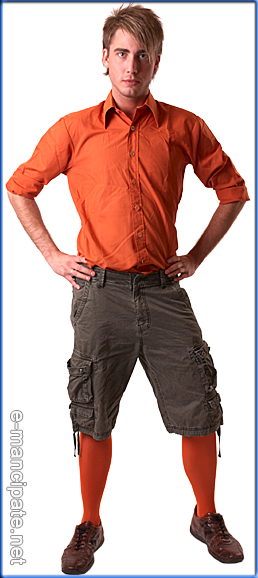
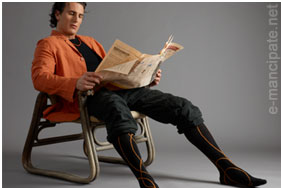
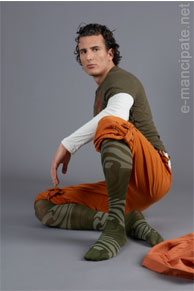
So how about pink pantyhose? Is pink too “femmy” for men?
The conclusion: “White pantyhose with floral patterns [as opposed to plain pink tights] makes you look like a man.”
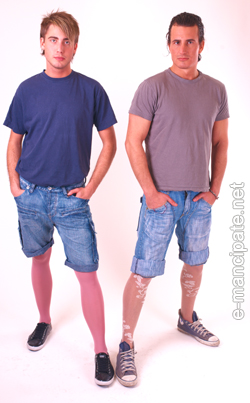
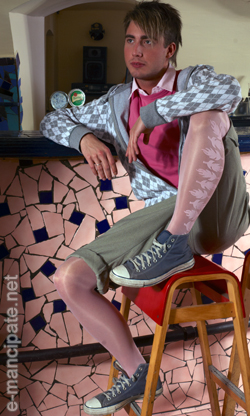 These images would be great for a class discussion on the reappropriation of gendered clothing items. What makes pantyhose specifically “manly” or “femmy”? Does this “e-MANcipation” reify the same old ideas about masculinity and femininity, or challenge and expand them?
These images would be great for a class discussion on the reappropriation of gendered clothing items. What makes pantyhose specifically “manly” or “femmy”? Does this “e-MANcipation” reify the same old ideas about masculinity and femininity, or challenge and expand them?
And I think it’s interesting that this website is U.K.-based. (UPDATE: The company is actually Hungarian– thanks to commenter “bozeman” for the clarification!) I have a hard time imagining a project like this in the U.S. How are ideas about what constitutes a “manly man” different from country to country?

Comments 28
Tiffani — March 13, 2009
To be honest, I think the guys in these pictures are super attractive, and I've always loved when guys wear tights (or other articles of clothing traditionally associated with women). But it just boggles my mind to see the way in which they try to "man it up". Can't a guy just be hot and a little genderqueer? I would never look at any of these guys and think they were super-butch, but I do appreciate the fact that there is a masculinity in their outfits.
I don't know. I don't think there's anything inherently wrong with having particular items of clothing more associated with one gender than another. It's a mark of identity. It's like saying American women are oppressed because they can't casually wear saris or something. And the advertising scheme on this website would be akin to saying, "Saris are super-American! American women wear saris because they're comfortable. It doesn't make them Indian!" I think people should wear whatever they want to, knowing that it might be associated with some kind of cultural identity...and if it becomes widespread enough, it might change in terms of what identity it expresses. But you can't force that paradigm shift by saying, "Tights are for manly men!"
Elena — March 13, 2009
Hoses were totally manly until trousers were adopted in the XIXth century. Really.
Elena — March 13, 2009
...And for some more modern fashion just before trousers became widespread, Horatio Nelson models a dashing combination of breeches and hose here. Sorry for the double post.
Tadjio — March 13, 2009
Oh hey, the fellow up there sporting the orange shirt/orange hose with gray cargo shorts -- I have that haircut :)
My boyfriend absolutely worships pantyhose and wears it regularly. He is also very, very effeminate (and would probably rail against these men pictured above as being largely "too butch" to do justice to the natural "femininity" he perceives pantyhose to possess.
With this clothing line, from what I can tell, a lot of effort is being made to divorce this clothes item from its perceived femininity. In the heydays of hose and heels for gents, these were not viewed as exclusively women's garments either and therefore were acceptable, even stylish for men to wear.
I think genuinely unisex clothing (styled with total androgyny in mind) is the way to go, if you want to challenge the definitions of gender as society sees it. I'm actually in favor of "let's take this item from the opposite gender and make it our own!" but it still seems like one has to alter whatever one is borrowing for it to "work." Like how you can steal your boyfriend's leather jacket, but you have to accessorize it with a long beaded necklace and a girly blouse so you don't become *too* transgressive; that sort of mentality.
MissPrism — March 14, 2009
They have a British phone number, but I'd lay money that the author of that site is not - phrases like "this collection was shot March 2008" are not British English.
Most importantly, I've never in my life heard a Brit use the word "pantyhose." We call them "tights."
bozeman — March 14, 2009
e-mancipate are not UK-based; they are in Hungary. Harisnya (which is the Hungarian word for 'tights') is the guy who runs the site, and he does a good job too. However, I would not use pictures of guys wearing women's tights (which all these shown here are (manufacturers of men's legwear would never make styles like these - they wouldn't sell!); I said at the time it was not a good idea, not least since there are plenty of tights which are made for men).
However, we sell thousands of pairs of men's tights to guys all over the world, and the trend is growing year-on-year (we commenced trading in 2004).
Legwear4Men
bozeman — March 14, 2009
Oh, and please do not use the term 'mantyhose'; that was the tradename for a dubious 1970's 'bedroom toy' and has nothing to do with legwear which is made for men. 'Tights' or 'legwear' will do fine.
Legwear4Men
Steve — March 14, 2009
ROTFLMAO
In most places in Britain we'd laugh and point at any guy dressed like this. In the rest, he'd probably have to run for his life.
a westie — March 14, 2009
What's interesting is that whenever they try to get a gender-specific (or at least highly favored by one gender) product to cross gender lines, they always make major changes to it rather than just saying, "You'd look better if you wore/used this," "Using this is fun!" or "This will improve your life in some way!"
I believe there was a 1960's ad campaign largely mocked online for a skirt to be worn by men. I think it was called a Skant or ManSkirt, or something like that. One image featured a guy holding a football while standing in his kitchen with a cup of coffee, perhaps to imply he still was masculine enough to enjoy sports...
Elena — March 14, 2009
But it's not a gender-specific article of clothing. It's a blip in the history of fashion that nowadays men aren't wearing hoses, that was my point.
PH Balanced — March 14, 2009
I have a manly job, and I wear men's pantyhose/tights in the cooler months for warmth. Heck, sometimes I even venture out dressed in hose and shorts! I applaud the emancipate website and others like them who are making it publicly known that it is OK for men to wear hosiery.
RSM — March 14, 2009
Leggings and tights for men is not a new trend - one that's been around for years. It's time to get over the body image constraints and go for the comfort. Just wear them. Leggings are perfect casual wear for women AND men. Having worn leggings for years, I'm aware of people's comments both negative and very positive. After all, it’s not the leggings on the man but the man in the leggings. Everyone looks good in leggings and some people look great!
If more people, women and men, wear leggings then it will just be another apparel choice. At one time denim jeans were worn only by miners digging for gold. Now they are everywhere and no one asks if you've struck gold.
So never say never - when you do decide to wear leggings, choose a well made pair - not with cotton fibers that bag out over time but a high tech fiber that retains its shape. Go for the comfort and support. Leggings that go to the ankle look better than capri style that chop the leg. Plus the full length leggings support you from your ankle to your waist and give you an energetic lift.
Usim — March 14, 2009
"Everyone looks good in leggings and some people look great!"
I really don't want to see my husband in tights. He is the hairiest person I know, and I can't imagine how "sexy" those swirls of leg hair under the tights would be (especially the sheer tights). Well, I guess I can, but I really don't want to, and I really don't think any of you honestly want to, either.
Village Idiot — March 15, 2009
Pantyhose were popular among some U.S. military units in Vietnam, but they didn't really talk about it much.
In swampy tropical areas, wearing pantyhose while on patrol made removing all the leeches easy when they returned; just take off the pantyhose and and your legs were instantly leech-free. They also work as coarse pre-filters for dirty water before boiling or treating it to make it potable.
Ads with Marines on patrol in the tropics wearing hose, and/or using them to live off the land (defeating leeches, communists, and gender stereotypes along the way) might help make pantyhose manly since the military is unambiguously tough and masculine, and has set fashion trends before (such as very short hair for men).
Short hair became fashionable for men around WWI since they were or wanted to imitate the returning veterans/heroes from the front, and armies at the time had begun making the soldiers shave their heads as a prevention measure against lice, which was rampant in the trenches. Now long hair on men is somewhat associated with them being hippies in touch with their 'feminine' side (unless they properly accessorize with black combat boots, a leather jacket, and death metal t-shirt). And let's not even get started about wigs. We don't laugh at depictions of George Washington (our top Founding Father no less) with his long hair, powdered wig, and tights.
Sociological Images » E-MANCIPATE: “MANTYHOSE” FOR MEN | MaleOutfit.Com — March 15, 2009
[...] View original post here: Sociological Images » E-MANCIPATE: “MANTYHOSE” FOR MEN [...]
Anon — March 15, 2009
Well, they might be trying to seperate hosery from the genderized stereotypes common today, or they might be trying to increase the market for hosery...just like they are doing for makeup.
Reagan — March 16, 2009
This definitely feels "European" to me (I know, I know...whatever that means!) and the more I think about it, I'm surprised this wasn't 'invented' sooner.
Todd — March 26, 2009
Members of the US ground forces, (I.E. Army/Marines) wear them currently in Iraq and Afganistan, I have heard to keep sand flies, chiggers etc (whatever the local variety is called) from getting through to the skin.
Joe — March 26, 2009
I wear them for vein support in my calves, which throb if I don't wear graduated support pantyhose. These kind are less tight around the midsection to allow the blood to flow up, and put less pressure on the male organs than regular hose. I would advise men who are interested in trying out tights or hose, to get some graduated support hose in the plus size, and then you won't be disappointed. Try the Futuro brand at your local Walgreens, and be ready to kick youself for never doing it before.
Anonymous — March 29, 2009
Honestly, when I first saw this site, I wondered if it was a thinly veiled fetish community. Language about enjoying the feel of the pantyhose, etc. really felt like the primary purpose of the community was to address a vaguely illicit motivation for wearing pantyhose.
It struck me as similar to feminization or clothing-based fetishes (underclothes, stockings etc.)
PS; I feel unsure bringing up these sorts of references, please strike my comment if they are found inappropriate.
Anon — March 29, 2009
Honestly, when I first saw this site, I wondered if it was a thinly veiled fetish community. Language about enjoying the feel of the pantyhose, etc. really felt like the primary purpose of the community was to address a vaguely illicit motivation for wearing pantyhose.
It struck me as similar to feminization or clothing-based fetishes (underclothes, stockings etc.)
PS; I feel unsure bringing up these sorts of references, please strike my comment if they are found inappropriate.
thelephant — April 13, 2009
let me just say all these pictures of guys in mantights make me feel funny in my girly tights.
Darrell — April 28, 2009
I'm a guy and I wear support pantyhose they fit and feel great and they keep my varicose veins in check and that's more important than worrying about fashion or gender specific generalization of pantyhose. I do think the textured hose look better on women though.
Steve Newman — May 15, 2009
I guess I'm a bit late in the game to be posting here, but I've only just run across this webpage. The writer states, "I have a hard time imagining a project like this in the U.S." Let me assure you that not only could a project like this be in the US, it was a US-based company that pioneered the whole men's legwear (ie, pantyhose/tights) trend.
I work for ActivSkin, and we opened for business in 1999 as the world's first company selling pantyhose and tights made especially for men. We've not only survived for 10 years, last year was our best ever for sales so far.
The e-MANcipate site depicts guys wearing legwear that's a lot more 'out there' than the more basic styles we sell (BTW, the hosiery shown on their models is women's hosiery--there are no men's legwear firms making styles like that at this time, either in the US or overseas). Nevertheless, men are taking up this emerging trend in bigger ways every day. Media attention and word of mouth has done it's job of overcoming the mindsets that placed such obstacles in the way of men wearing hosiery because it was considered 'feminine' and therefore 'bad'. Now, we're wearing them because we realize the benefits that can be found in support legwear.
For more information and discussion on this, visit my blog, The Nylon Gene (www.nylongene.com)
Paul Harrison — January 6, 2010
Men in tights from a 16th century Italian dance manual, showing off their athletic dancing legs:
http://www.pbm.com/~lindahl/caroso/images.html
Note also that the women are the same height as the men (this may be because they are wearing platform shoes).
Ziz — January 16, 2010
This is very interesting what has been written here..... As I have pondered over this question on gender and Pantyhose/Tights. Personally having looked at this subject and other so called gender specific wear we me in the Western world have a sad general wardrobe of dark no colours for our cloths or of really bad designs with stupid pictures or writing as in the casual wear market. As a man in my mid 40's I do go and look for the more colourful cloths and push the boundaries between the so called fashion gender gap. Tights, Leggings, Robes, Skirts etc. As these really can be for either sex. Its the western perception forced on us by the... you can't wear tights under your trousers even if it is minus 10 Degrees C outside go and suffer bad circulation and get a bit of cold rash on your legs your a Man.... As men we really have to take back some of the fashion ground and say we can wear this. I've gone to the local town center in tights and shorts and the local supermarket and not a eyelid batted at me for having tights on..... Men's fashion needs to become a thing of beauty again elegant tasteful showoff the Peacock way and this comment I'm sure will get a back up or two.... I've seen lots of men with better legs than women out there so show them off.. just remove the hair from your legs... find the size that fits don't let the wife and kids put you off... learn a bit of male fashion history... and your away on your way to a more elegant stylish way of dressing....
Flavio Capez — September 17, 2014
Those socks would fit enormously well on fat boys. The classic blacks, mostly.
Pantyhose King — March 29, 2024
This article has aged like milk. I do a men's pantyhose podcast and we talk about how articles like these, while groundbreaking, show an enormous insecurity about what constitutes being a man and what doesn't. Men who wear pantyhose have evolved past this dated point of view.